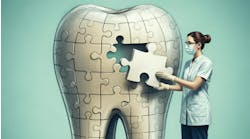by T. Roy Nakai, DDS, MSD
Why should one in the dental profession ponder this title question that seems so vastly unrelated? On the one hand, we have Nordstrom and Wal-Mart — large, highly successful national sales companies — and on the other, a far-removed health profession. If we examine each from a perspective that we normally would not consider, there is an answer that can be a revelation.
Nordstrom and Wal-Mart credit their success in their mission statements as providing "effective and exceptional customer service." These successful companies realize that the customers' total experience relates to their satisfaction as customers. Every encounter makes a lasting impression on his or her satisfaction. Realizing this fact, the companies painstakingly train all of their employees in all aspects of customer service so the client has an exceptional experience when shopping or contacting their stores.
Let us continue with this thought process and develop a relationship and comparison to high-tech digital dentistry. For many years now, most of the dental articles have pointed toward the incorporation of digital products. Many discuss the profitability and the return on investment of going digital, both in the area of using extraoral and intraoral cameras, as well as digital radiography. It is estimated that 12 to 16 percent of dentists have taken the total "plunge" and incorporated all of the digital technologies. This decision is not inexpensive for the doctor and the financial return must be evaluated. As a consultant and technology trainer, I have seen how it has resulted in wide variations of impact on dental practices. Some have shown profit and investment returns, while others have not. What is the defining difference between these practices?
The use of the technology is the same, but the difference lies in how the technology is presented to the patient. Returning to our discussion of Nordstrom and Wal-Mart and their effective promotion of customer service will give us this key for success. If the dentist makes the transition to high-tech digital dentistry and does not incorporate the necessary changes and processes toward customer-service applications, he or she will struggle with profitability. Merely owning the technology is not enough in this highly informational society.
Fifteen percent inside the mouth, 85 percent outside the mouth
Dr. Joe Steven in his "Kisco Perspective Newsletter" states that patients continue to seek care from their dentist by what occurs inside of their mouths 15 percent of the time, and what occurs outside of their mouths 85 percent of the time. In simple terms, patients expect the dentistry in their mouths to be good, but their perception of the practice and how they are treated as customers is the major reason they continue to return. This is an accurate statement also when it encompasses the implementation of high-tech digital dentistry into the practice.
Implementing digital technologies
Let us look at a very good example of this implementation process and analyze both the thought and planning aspects. A good friend and colleague of mine, Dr. Jim McDonald of Phoenix, Ariz., was evaluating his practice that has been high-tech for many years. Jim is one of those pioneers who were on the "bleeding edge" of computer and dental technology implementation.
For several years now, he has had all the components to become totally paperless and is finally making this transition, however, becoming paperless is only a minor area of his concerns. He is an excellent clinician and does beautiful dentistry, but has felt that his clinical dentistry has had to compensate for his many other concerns in the area of customer service.
Dr. McDonald understood from the outset that using a single data base practice-management and clinical-management software that was fully integrated with his digital technologies was critical for success. Jim uses EagleSoft practice-management and clinical-management software and integrates a Canon digital camera, Reveal intraoral cameras, and Schick digital radiography in his office. As I mentioned in a previous article, "Controlling the chaotic storm in paperless dentistry" (Dental Economics, September 2002) on single data base systems, it is important for the dentist to evaluate his or her software and its integrating digital components. If one has PracticeWorks or Softdent as practice- and clinical-management software, then Trophy digital radiography is the integrating format. If one uses Dentrix software, then DENTRIX DDO radiography is the integrating format. An understanding of this integration is important for the successful implementation of digital dental components.
Dr. McDonald's practice makes extensive use of intraoral cameras and digital radiography before, during, and after treatment, both in the hygiene as well as restorative treatment areas. With computer monitors at each chair, his patients are continually amazed at what they see. But even with all this digital technology, he was concerned about patient flow and whether his patients fully understood and appreciated all aspects of their treatment and financial plans. His concerns are very real and not uncommon when implementing digital technologies. This hurdle, if overcome, would lead to a higher case-acceptance level as well as better follow-up care because they would have a greater appreciation of their care.
Client advocate or concierge
In sitting down with Jim and his staff to analyze the entire patient contact and treatment process, we looked at what was influencing patients from the initial phone contact to their scheduling for a re-care visit. We determined that the main hurdle was the lack of continuity for the patient throughout the entire dental process. The patient's total impression has a profound influence on not only his or her acceptance of our dental treatment recommendations, but also on referrals of family and friends and a continuing relationship as a patient.
Jim realizes that a satisfied customer is not always a good referral source; the patient must have an exceptional experience in the dental office to become an enthusiastic referring source. With this information in hand, and after careful analysis, it was determined that they needed to create an office position that was essentially a client advocate or concierge. This position would create and maintain continuity and limit the number of "pass-offs" the patient experienced during the entire dental experience. The person would be the main contact for the patient whether questions arose concerning treatment, scheduling, finances, or educational needs. Other staff members would intervene at necessary times for the completion of particular needs and treatment, but the client advocate or concierge would oversee the entire process so that, from the patient's point of view, everything was seamless. More importantly, patients would feel they are "The Center of the Universe" in Dr. McDonald's dental practice. After our consulting session and with a great deal of relief seen in Jim's countenance, he commented that it seemed like such an easy and obvious call that it didn't seem possible that he could overlook something that was staring him in the face for a such long period of time.
Beyond dentistry to Corporate America for answers
If we are to spend time with our patients to provide them with optimal customer service, where does this time come from? Where does the receptionist find time while handling phone calls, scheduling updates, and handling financial considerations? Where does the office manager find time while managing everything from accounts receivables to staff concerns? Where does the hygienist find time — one who is scheduled in specific time increments to complete scaling and root planing as well as oral hygiene instructions and often scheduling the next re-care appointment? Where does the chairside assistant find time while assisting the doctor, breaking down and setting up treatment rooms, and processing instruments to be sterilized? And lastly, where does the Doctor — around whom everything concerning time revolves — find this precious time? Time has always been and will always be the number-one and most precious commodity in dentistry. We have always looked within our profession to attempt to solve this on-going dilemma with only limited results.
It is time to look beyond dentistry and look to the resources of big business and Corporate America for answers. Jerry Willbur, CEO of Master Dentist Institute of Vancouver, Wash., and I were recently having dinner prior to a seminar in which we were both participating. We had both recently shared an audio tape by Dr. David Ahearn, president of Design Ergonomics. His tape discusses the three major bottlenecks in dentistry and how he wants dentists to evaluate his innovative ergonomic designs for the dental office. This design approach would help improve efficiency and begin to solve some of the bottleneck problems. His bottlenecks are 1) the sterilization area, 2) the operatory area, and 3) the front desk. Jerry and I agreed on almost all of the areas mentioned and discussed them at length. I then mentioned I had an article in mind to write on customer service and high-tech digital technology. I recounted many of the points and concerns I had, as well as many of the aforementioned conclusions.
During our conversation, Jerry introduced me to the management methodology called Six Sigma, which he has incorporated into his management teachings for several years now. As we continued, I could see how almost every aspect of my concerns with customer service, high-tech digital dentistry, efficiency, and time had some form of relevancy with Six Sigma. After dinner, we went directly to Barnes and Noble to buy books he recommended I read. Jerry had created an epiphany for me that night, because I realized that dentistry can borrow from companies such as General Electric, Motorola, IBM, and Texas Instruments — companies that have successfully implemented Six Sigma — to begin solving problems in dentistry. In 1999, General Electric used Six Sigma to add more than $2 billion to their bottom line. Motorola, one of the first companies to implement this technology, saved more than $15 billion in the first 10 years of using Six Sigma.
What can Six Sigma contribute to dentistry?
In a nutshell, Six Sigma is "a problem-solving technology that uses your human assets, data, measurements, and statistics to identify the vital few factors to decrease waste and defects while increasing customer satisfaction, profit, and shareholder value. By changing the way you look at processes, by understanding the vital few factors that cause waste, error, and rework, you can improve the ability of your processes to deliver higher quality to your customers, and to lower costs. Once you know which vital few factors to focus on, you can make improvements that deliver dramatic results" (from "Six Sigma for Managers" by Greg Brue and McGraw Hill Briefcase Books).
Dr. David Ahearn identified three bottlenecks in the dental office as vital factors for efficiency improvement. Let us expand not only on numerous other bottlenecks within a dental practice, but also on other efficiency-reducing and time-depriving vital factors. Paper in a dental office is a prime target for bottlenecking. Almost 90 percent of practices still use paper dental charts. These charts contain an assortment of information that a variety of staff members need at various times. As such, staff members have to wait and lose precious time while the chart goes from person to person. This downtime results in a decrease of productivity and profitability.
Once a dental office goes to a purely digital format, the paper bottleneck is resolved. Each staff member has access to the patient's information through a computer workstation at any time it is needed. This freed-up time can be directed toward greater customer service. In addition, changing from film-based radiography and chemical developing to digital radiography has been proven time and time again to not only be more efficient, more diagnostic, and more cost-effective, but also
to save time. By networking computers in operatories, we can process many of the functions that occur at the front desk bottleneck. Now that we can identify some of the vital factors, we need to superimpose Six Sigma methodology to resolve them.
• Define the projects, goals, and deliverables to customers (internal and external)
• Measure the current performance of the process
• Analyze and determine the root cause(s) of the defects
• Improve the process to eliminate defects
• Control the performance of the process
Dental laboratories have commented from many studies that there are as many as six remakes for every 100 porcelain crowns made. Of these six, three remakes are due to color selection problems. Crown remakes are an ideal example for the implementation of Six Sigma. A colleague, Dr. Douglas Wirth of Oak Harbor, Wash., takes his shade readings in the same operatory at the same time of the day to eliminate errors caused by varying illumination. Doug may not be aware of Six Sigma, but he is implementing methods to eliminate defects.
Several electronic shade-taking instruments have been developed that measure densities and translucencies of tooth structure for more optimal shade selection. This is yet another available technology to eliminate defects in our office procedures and realize cost savings.
Nordstrom and Wal-Mart revisited
Let us return to the original theme of this article. In order to incorporate high-tech digital technologies successfully and profitably into the dental practice, we must create a Nordstrom and Wal-Mart type of customer service environment for our patients. We must educate them visually and assist them using co-diagnosis treatment-plan presentations along with digital radiographs and intraoral and extraoral digital photographs.
By borrowing Six Sigma methodologies used by Corporate America, we can become more efficient, eliminate bottlenecks, and make more time for creating the type of customer service that will make our patients feel like they are "The Center of the Universe." This attention to the patient will enable the practice to use high-tech digital formats to become more profitable.
Successful and profitable digital offices have a number of things in common:• Incorporated and embedded clinical software and digital formats in each operatory.
• Use digital technologies such as extraoral and intraoral digital cameras and digital radiographs to educate their patients visually.
• Use these visual records in their treatment-plan presentations.
• Have their patients participate in a co-diagnosis format during the treatment-plan process.
• Obtain 85 to 90 percent levels of case acceptance.
• Highly train all staff members in the presentation and explanation of these digital formats for consistency and standardization of information.
• Adopt as a part of the office mission the promise that the patient is considered "The Center of the Universe" when it comes to customer service.





